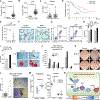Methylation of dual-specificity phosphatase 4 controls cell differentiation
- PMID: 34320342
- PMCID: PMC9110119
- DOI: 10.1016/j.celrep.2021.109421
Methylation of dual-specificity phosphatase 4 controls cell differentiation
Abstract
Mitogen-activated protein kinases (MAPKs) are inactivated by dual-specificity phosphatases (DUSPs), the activities of which are tightly regulated during cell differentiation. Using knockdown screening and single-cell transcriptional analysis, we demonstrate that DUSP4 is the phosphatase that specifically inactivates p38 kinase to promote megakaryocyte (Mk) differentiation. Mechanistically, PRMT1-mediated methylation of DUSP4 triggers its ubiquitinylation by an E3 ligase HUWE1. Interestingly, the mechanistic axis of the DUSP4 degradation and p38 activation is also associated with a transcriptional signature of immune activation in Mk cells. In the context of thrombocytopenia observed in myelodysplastic syndrome (MDS), we demonstrate that high levels of p38 MAPK and PRMT1 are associated with low platelet counts and adverse prognosis, while pharmacological inhibition of p38 MAPK or PRMT1 stimulates megakaryopoiesis. These findings provide mechanistic insights into the role of the PRMT1-DUSP4-p38 axis on Mk differentiation and present a strategy for treatment of thrombocytopenia associated with MDS.
Trial registration: ClinicalTrials.gov NCT01496495.
Keywords: DUSP4; HUWE1; MDS; PRMT1; leukemia; megakaryocyte; myelodysplasia syndrome; p38; platlet; trombocytopenia.
Copyright © 2021 The Authors. Published by Elsevier Inc. All rights reserved.
Conflict of interest statement
Declaration of interests M.L. has served on the Scientific Advisory Board for Epi One. A.V. has received research funding from GlaxoSmithKline, Incyte, MedPacto, Novartis, Curis, and Eli Lilly and Company; has received compensation as a scientific advisor to Novartis, Stelexis Therapeutics, Acceleron Pharma, and Celgene; and has equity ownership in Stelexis Therapeutics. The remaining authors declare no competing interests. Array BioPharma provided the p38 inhibitor pexmetinib (ARRY614) and participated in its phase I study (ClinicalTrials.gov: NCT01496495).
Figures







Similar articles
-
Proteomic Signaling of Dual-Specificity Phosphatase 4 (DUSP4) in Alzheimer's Disease.Biomolecules. 2024 Jan 3;14(1):66. doi: 10.3390/biom14010066. Biomolecules. 2024. PMID: 38254666 Free PMC article.
-
Protein arginine methyltransferase 1 in the generation of immune megakaryocytes: A perspective review.J Biol Chem. 2022 Nov;298(11):102517. doi: 10.1016/j.jbc.2022.102517. Epub 2022 Sep 21. J Biol Chem. 2022. PMID: 36152748 Free PMC article. Review.
-
Dual inhibition of P38 MAPK and JNK pathways preserves stemness markers and alleviates premature activation of muscle stem cells during isolation.Stem Cell Res Ther. 2024 Jun 21;15(1):179. doi: 10.1186/s13287-024-03795-0. Stem Cell Res Ther. 2024. PMID: 38902774 Free PMC article.
-
Comparative Monomethylarginine Proteomics Suggests that Protein Arginine Methyltransferase 1 (PRMT1) is a Significant Contributor to Arginine Monomethylation in Toxoplasma gondii.Mol Cell Proteomics. 2017 Apr;16(4):567-580. doi: 10.1074/mcp.M117.066951. Epub 2017 Jan 31. Mol Cell Proteomics. 2017. PMID: 28143887 Free PMC article.
-
Thrombopoietin mimetics for patients with myelodysplastic syndromes.Cochrane Database Syst Rev. 2017 Sep 30;9(9):CD009883. doi: 10.1002/14651858.CD009883.pub2. Cochrane Database Syst Rev. 2017. PMID: 28962071 Free PMC article.
Cited by
-
PRMT1 in human neoplasm: cancer biology and potential therapeutic target.Cell Commun Signal. 2024 Feb 8;22(1):102. doi: 10.1186/s12964-024-01506-z. Cell Commun Signal. 2024. PMID: 38326807 Free PMC article. Review.
-
Proteomic Signaling of Dual-Specificity Phosphatase 4 (DUSP4) in Alzheimer's Disease.Biomolecules. 2024 Jan 3;14(1):66. doi: 10.3390/biom14010066. Biomolecules. 2024. PMID: 38254666 Free PMC article.
-
MSI2 mediates WNT/β-Catenin pathway function in hematopoietic stem cells.Leukemia. 2025 Jan;39(1):265-270. doi: 10.1038/s41375-024-02447-9. Epub 2024 Oct 22. Leukemia. 2025. PMID: 39438589 No abstract available.
-
Integrated multiomics machine learning and mediated Mendelian randomization investigate the molecular subtypes and prognosis lung squamous cell carcinoma.Transl Lung Cancer Res. 2025 Mar 31;14(3):857-877. doi: 10.21037/tlcr-24-891. Epub 2025 Mar 18. Transl Lung Cancer Res. 2025. PMID: 40248728 Free PMC article.
-
Profiling and Validation of Live-Cell Protein Methylation with Engineered Enzymes and Methionine Analogues.Curr Protoc. 2021 Aug;1(8):e213. doi: 10.1002/cpz1.213. Curr Protoc. 2021. PMID: 34370893 Free PMC article.
References
-
- Bachegowda L, Morrone K, Winski SL, Mantzaris I, Bartenstein M, Ramachandra N, Giricz O, Sukrithan V, Nwankwo G, Shahnaz S, et al. (2016). Pexmetinib: A novel dual inhibitor of Tie2 and p38 MAPK with efficacy in preclinical models of myelodysplastic syndromes and acute myeloid leuke mia. Cancer Res. 76, 4841–4849. - PMC - PubMed
Publication types
MeSH terms
Substances
Associated data
Grants and funding
LinkOut - more resources
Full Text Sources
Medical
Molecular Biology Databases
Research Materials
Miscellaneous

